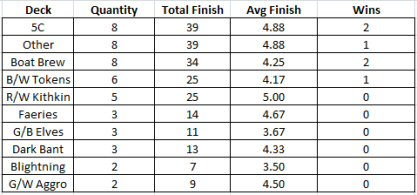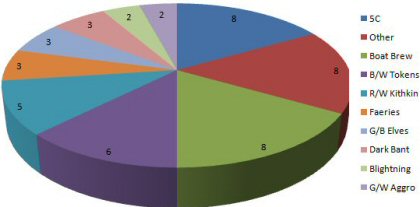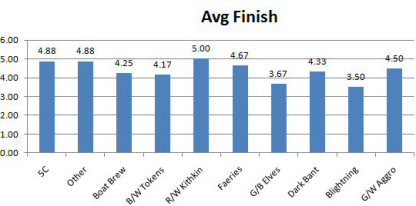I’m feeling like the odd man out right now, in that the format that matters the most to me in upcoming months is Vintage. Between now and June, I expect to play in four Vintage events (one Princeton Magic event, two CCGames events at AU Blue Bell, and the Philly Open 3), at least two of which will probably have a Mox as first prize, and one is due to offer up a Black Lotus. All of these tournaments are within an hour of my house, none should have more than 80 or so players, and all probably have a $25 entry fee. Talk about positive EV! I don’t know if I’m seeing the beginning of a Vintage resurgence in the PA/NJ area, or I’m just more aware of these events now that I’m getting deeper into the format, but it’s pretty exciting. At least, it’s exciting for me — probably not so much for most of you out there.
After all, we’re in the middle of the Standard preseason. For most Magic players, we’re entering a very exciting period that puts Standard front and center, with Regionals leading into a PTQ Season featuring the most popular Constructed format on the planet. The month of March featured several large Standard events in the United States and Europe, and analyzing that data should give us an idea how the pre-Alara Reborn Standard format is shaping up. Unless the new set has some truly tremendous card (on the level of Tarmogoyf or Bitterblossom), the format should remain relatively static given the already large card pool, so it is definitely worth it to explore the format as it stands right now.
Although my personal focus is going to be on Vintage, I absolutely will be playing in Regionals and the PTQ season. It has been a while since I’ve really been in touch with Standard, as the general poor performance of straight-up aggro decks, along with a noticeable lack of any combo deck of any shape or form, is something of a turn-off for me. That said, I have had fun playing Five-Color Control, and I expect that will be the deck I’ll run for Regionals and quite possibly for the early PTQs.
In order to get myself plugged back into the Standard format, I scoured the vast interwebs for data. SCG has links on the front page to Standard decks from two $5000 Standard Open events, plus a Pro Tour and a Cruise Qualifier, so this is a good place to start (although the PT and the SCG $5K in Richmond, both from February, are already starting to look dated). Some more digging elsewhere revealed a wealth of info in tournaments from Europe. I have an obvious preference for larger events when combing for data, and found two tournaments in Germany that had over 100 players, and one in Portugal that had 96.
Now, the hard part: what do we do with all of that data? While we’ve seen plenty of analysis on individual events, there isn’t a single place to analyze Standard data across the larger tournaments from March. Without that analysis, how can we figure out what to play?
Maybe this will help:

Above, you’ll find the raw data that I pulled from the six events I just mentioned. This is useful in and of itself, but I want to take a deeper look. How prevalent is each deck across the elimination rounds of these six tournaments, and what is the average finish?

Now, we can start to get a feel for the decks that made up these Top 8s. Before digging in, some visual aids might be of assistance:


First, we see that Five-Color Control and Boat Brew were the two most common decks among these top 8s, and won 4 out of the 6 of these tournaments. Both of these decks have been discussed at length, so I won’t go into detail here, other than to say that Five-Color Control continues to shift itself and adapt to the metagame. That “Other” winner was Grixis Control, which shares many elements of traditional Five-Color Control, but sheds the Vivid lands and runs a play-set of Makeshift Mannequins (along with a Nicol Bolas, Planeswalker). Note that this deck beat a traditional Five-Color Control in the finals, and looks particularly strong in that quasi-mirror.
Of the most common decks represented (in order of prevalence: Five-Color Control, Boat Brew, B/W Tokens, R/W Kithkin), Boat Brew had the second-best overall finish despite its high representation. B/W Tokens also looks relatively impressive, winning one tournament out of six chances, with an average finish of 4.17, the best of the major archetypes. On the lower end was R/W Kithkin (often called Vengeant Weenie), which has many similarities with B/W Tokens, but chooses to play a Kithkin base and Ajani Vengeant rather than the disruptive elements of B/W Tokens.
Past these top four, we see Faeries, seemingly pushed from its perch atop Standard at last. Three Faeries decks made it through the Swiss of these events, but none could achieve better than a semi-finals appearance. Similarly deposed is Blightning Aggro, which put only two decks in the Top 8. Neither of these decks was able to win, echoing a trend we saw at PT: Kyoto. Blightning as an archetype seems outclassed and outdated.
To me, the most interesting trend that we see here is a return of base-Green Aggro decks. Two tournaments had G/B Elves make the top 8, along with three Dark Bant, two G/W Aggro, and one Mono-Green Elves!-style deck. As Volcanic Fallout has quickly become one of the defining cards of this metagame, running huge beaters may suddenly be en vogue again. In a format where Wrath of God is considered passé, and Path to Exile seems to be cooling off, the speed and power of Elves and Dark Bant (along with traditional Doran, now with extra disruption in the form of TIdehollow Sculler) can come into play and overwhelm decks relying on sweepers like Fallout and Infest.
Finally, it’s interesting to see the relative parity that this chart reveals. There is in no way a breakaway front-runner based on this data. Boat Brew and Five-Color Control won the most, and showed up the most in these Top 8s, but they are also among the more popular decks and I would expect that they made up a similar percentage of the overall total tournament population. The same is likely true for R/W Kithkin and B/W Tokens. With the “other” decks posting a similar average finish to the decks considered front-runners, what does that say about this Standard format? I believe it is safe to suggest that the top decks are beginning to reach parity, meaning that correct sideboard construction and tight play, rather than deck innovation or technology, will be needed to get any type of edge at Regionals and the ensuing PTQ season.
That said, we’re seeing innovation continue even as this Standard format reaches its final maturation. Aggro decks appear to be making a much-needed comeback, although these are decks based on green and white rather than red. The traditional pillars of this Standard format — Reveillark, Bitterblossom, Cryptic Command, Figure of Destiny, Spectral Procession, Cruel Ultimatum — are being joined, as they were in block season, by Doran, Profane Command, and Thoughtseize. Patrick Chapin ran his Doran deck, really a throwback to Block Constructed Doran, to an 8-2 record at the Indy SCG $5K, showing again that Elves and Doran can be contenders in an unfocused, open field.
Clearly lacking from this metagame is a traditional RDW-style beater. Base-Red decks are fighting an unfortunate uphill battle against Forge[/author]-Tender”]Burrenton [author name="Forge"]Forge[/author]-Tender, Wall of Reverence, and Kitchen Finks, and tend to struggle against decks that can spit out tokens and power them up with Ajani Goldmane and Glorious Anthem. A resurgence of base-Green decks running Doran and Wilt-Leaf Liege isn’t helping things. That said, we know Alara Reborn has at least one new two-drop that could help make this a playable archetype again: Jund Hackblade. A 3/2 with Haste, following a one-drop, and followed up by another source of immediate pressure, might be fast enough to race most of these decks. A starting point might be something along these lines:
Hackblade Beatdown
4 Tattermunge Maniac
4 Figure of Destiny
4 Jund Hackblade
4 Hellspark Elemental
4 Boggart Ram-Gang
4 Demigod of Revenge
4 Tarfire
4 Incinerate
4 Flame Javelin
4 Auntie’s Hovel
4 Sulfurous Springs
3 Graven Cairns
3 Ghitu Encampment
10 Mountain
Although I’m not a fan of Tarfire, it helps keep the Goblin count high enough to run the Auntie’s Hovel and gives you a cheap removal option for Knight of Meadowgrain, Sower of Temptation, TIdehollow Sculler, and Noble Hierarch. This build does not run Blightning, as I would rather have Flame Javelin to combat large beaters and give me the ability to blast through Wilt-leaf Liege and Plumeveil. Running this many creatures with Haste gives the deck an entirely different feel than the slow, ponderous Red decks we saw last summer such as Demigod Red. Both Faeries and Five Color should struggle with a hand that leads off with Maniac into Hackblade into Ram-Gang (which, unchecked, has already dealt 13 damage at the end of the third turn).
There are a lot of different directions we could take this deck, of course. One option would be to pull the Demigod of Revenge and replace it with something lower in cost like Ashenmoor Gouger or Shambling Remains. This could allow the deck to shave off a few lands and run additional burn or disruption like Thoughtseize (perhaps in combination with Blightning, should disruption prove more effective in this metagame than burn).
To get more value out of Maniac, Hackblade, and Ram-Gang, Boartusk Liege could actually find a home here. I’m also not completely sold on Hellspark Elemental in this format, and that card might be better off being Goblin Outlander. Alara Reborn gives this deck a potent removal spell in Terminate, which deals with Doran and Wall of Reverence. That said, I think this deck is probably one more two-drop away from being playable. Time Spiral / Ravnica Standard really spoiled us in this slot, and Outlander, Stigma Lasher, and Hellspark all seem mediocre. With any luck there are some potential playables in Alara Reborn waiting to push this deck over the edge.
The sideboard would have to have a way of dealing with Wall of Reverence, perhaps Terror, Terminate, or Shriekmaw, and Forge[/author]-Tender”]Burrenton [author name="Forge"]Forge[/author]-Tender. It would also need some form of board-sweeper to combat the token decks, such as Volcanic Fallout. Tattermunge Maniac is really the weak link here, in that he is awful as a deck-top, and is miserably bad against Wall of Reverence, Forge-Tender, and Spectral Procession. Given that powering up Hackblade requires a solid one-drop, I’m not sure there is any way to avoid this problem, and that might hamstring the whole archetype. Because of this fact, although I really want to get excited about Hackblade, I’m struggling to do so.
Postscript
The first time I played against Dan Herd was in an Extended tournament. I was sitting at 2-1-1 and basically a lock for Top 8, since this was a smaller side event, while Dan needed a win to get to 3-2 and make the cut. I was running Enduring Ideal, a version I’d tuned throughout the season to be extremely good against the various levels of Blue and Tron, while Dan was running U/G Tron in a format he wasn’t all that familiar with. The first game, I drew the nuts hand, and although I drew Dovescape on turn 3, Dan had tapped out and given me a chance to resolve Ideal. I confidently drew for my fourth turn and, of course, saw the second Dovescape (obviously, for those who know me). I ended up losing that game, although I made Dan work for it. The second game, I had a full playset of Boseiju AND Extirpate in my deck, and won easily. In game 3, I had to mulligan to five, and that made it a struggle. I don’t remember the exact situation, but I remember quite vividly that Dan was about to lose unless he could draw a Thirst for Knowledge off a Repeal on his own Chrome Mox, and then had to cast Thirst for Knowledge, needing to draw Chrome Mox PLUS a Blue spell to imprint PLUS another artifact to discard, in order to win. Naturally he got there — this was Dan Herd we’re talking about.
The second time I played Dan was in Vintage. He got a game loss for deck mis-registration, so we only played one game, and I won very quickly off a first-turn Oath and Orchard. Those of you that knew Dan know that he wasn’t always inclined to take these kinds of things well, especially knowing that I rarely played Vintage while he was trying to win the CCGames Champions race in order to play for free in 2009. Despite this, Dan didn’t complain or whine to me, but I did hear him talking to himself, refocusing and keeping himself from going on tilt. Dan ended up making the Top 8 and winning the Champions point race, an impressive feat given the quality of players often at these events.
I didn’t know Dan all that well, but I do know that he was a strong personality and was present at nearly every local Vintage event, and he was most definitely not someone I wanted to be paired against because you always knew you’d be in for a battle. The last time I saw Dan, he was playing Vintage, as usual, but this time he had a seat at table one all day and a protective surgical mask. Dan had leukemia. He told us how he’d informed his doctor that there was no way he was going to miss this tournament.
Plenty of articles on this website will tell you how to win and lose games of Magic. What they don’t talk about often enough is how being able to play this game at all is a win in and of itself. In the two years since I’ve started playing again, I’ve been lucky enough to win some awesome prizes, and I’m particularly proud of the opportunity I have to write for this website. Most of all, I feel lucky to have rejoined this game and this community, and have met some truly amazing people that I hope to be friends with for a long time. The Vintage community in particular tends to be a little older and more tight-knit, and losing someone like Dan will sting for some time to come. I know it will be in my thoughts the next time I’m playing and get overly upset at some truly miniscule happening, some loss that barely hints at what that word means for those that were close to Dan.
Rest in Peace, Dan Herd – CCGames Champions Winner 2008
Matt Elias
[email protected]
Voltron00x on Xbox Live and SCG Forums

